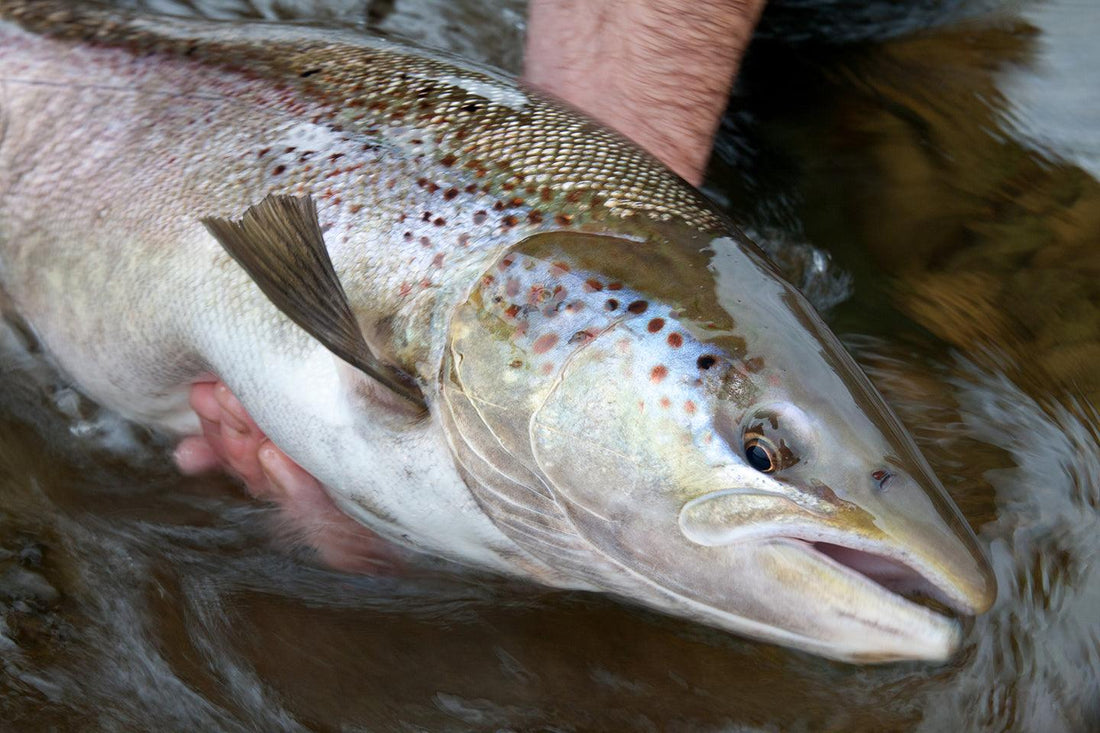If you only know the names of two fish in the world, they’ll probably be Salmon and Trout. These guys are the most popular fish on the market. They’re also the reason fly fishing – arguably, sportfishing in general – exists. People have stocked Trout and Salmon in the most remote corners of the planet, from Argentina to Tasmania and well beyond. But what makes a species Trout vs. Salmon?

Is this a Trout or a Salmon, and what does that mean, anyway?
There’s a lot of confusion around this famous fishy family. In this short guide, you can learn the difference between Trout and Salmon. Find out how the families fit together and which ones are the tastiest in each group.
Trout vs. Salmon: Meet the Family
You might expect “Trout” and “Salmon” to be some scientific classification. It’s not at all. Is it to do with where they live, then? Nope. The names are actually more branding than biology. For example, Atlantic Salmon is more closely related to Brown Trout than other Salmon species. We’ve covered North America’s Troutand Salmon in more detail elsewhere. For now, here’s a rough guide to how they all fit together:
Pacific Trouts and Salmons
This is the largest group in North America. It includes five different Salmons (Chinook, Coho, Sockeye, Pink, and Chum), as well as the two most widespread Trouts (Rainbow and Cutthroat). They traditionally live along the Pacific coast, and are a common catch from Alaska to California. These days, you can also find most of them in the Great Lakes.
Atlantic Trouts and Salmons
These are the “original” Trout and Salmon. As the name suggests, Atlantic Salmon lives in the Atlantic, and shows up both in North America and in Europe. When European settlers came to America, they named the species they discovered after their favorite fish back home. They also brought Brown Trout with them, which isn’t native to North America.
Chars
You may have never heard of Char, but it’s actually the most widely-spread group of them all. Chars are a type of salmonid that are specially designed to survive in freezing temperatures. They live in cold, northern waters all around the world. Most of the ones in North America are in Canada and Alaska, so American anglers don’t tend to come across them as much.
What tastes better, Trout or Salmon?

This is the most important point for a lot of people. Obviously, they don’t all taste the same. Some Salmon taste better than some Trout and vice versa. Here are the most common species for sale in North America, and how they compare as food.
Rainbow Trout
Most of the Trout for sale in North America is Rainbow Trout. The pinkish meat is mild and delicate, and they’re generally the perfect serving size for one per person. Rainbow Trout doesn’t usually taste too “fishy.” It can sometimes have a slight muddy taste, though, depending on where it was raised.
Steelhead Trout
This is actually the ocean-going version of Rainbow Trout. Despite that, the two do taste a little different. A life at sea and a different diet give Steelhead a slightly fresher flavor, with none of the muddy backtaste. They also tend to have darker, fattier meat, similar to Salmon.
Sockeye Salmon
 Sockeye meat is much redder than most Salmon.
Sockeye meat is much redder than most Salmon.
Sockeye are widely considered to be the tastiest of the Pacific Salmons. They’re also the most expensive. Their meat is a deep red, much darker than other fish in the family. Sockeye fillets are among the highest in fat, giving them extra flavor and allowing them to cook through without going dry.
Chinook Salmon
Chinook is also premium table fare, rivaling Sockeye for many people. The meat is softer than many other Salmon species, with a distinctly rich and buttery flavor. It has even more fat that Sockeye, but isn’t quite as dark. Chinook are also the biggest Salmon, if you’re looking to put on a feast.
Atlantic Salmon
Wild Atlantic Salmon is too tasty for its own good. The species was overfished for decades and is now endangered in the wild. Pretty much all Atlantic Salmon is farmed these days. Even so, it’s delicious. The meat is milder and less fatty than other Salmon species, and breaks into large, moist flakes when cooked.
And the Rest!
There are a load more fish to choose from. Most of them are delicious. The one to avoid is Chum Salmon, which is considered the least tasty of the bunch. Chars are generally a lot more oily (especially Lake Trout). If oily fish are your thing, you’re in for a treat. If not, it may be best to stick with staple food fare like Steelhead Trout and Salmon.
Read full article at https://fishingbooker.com/blog/trout-vs-salmon/

